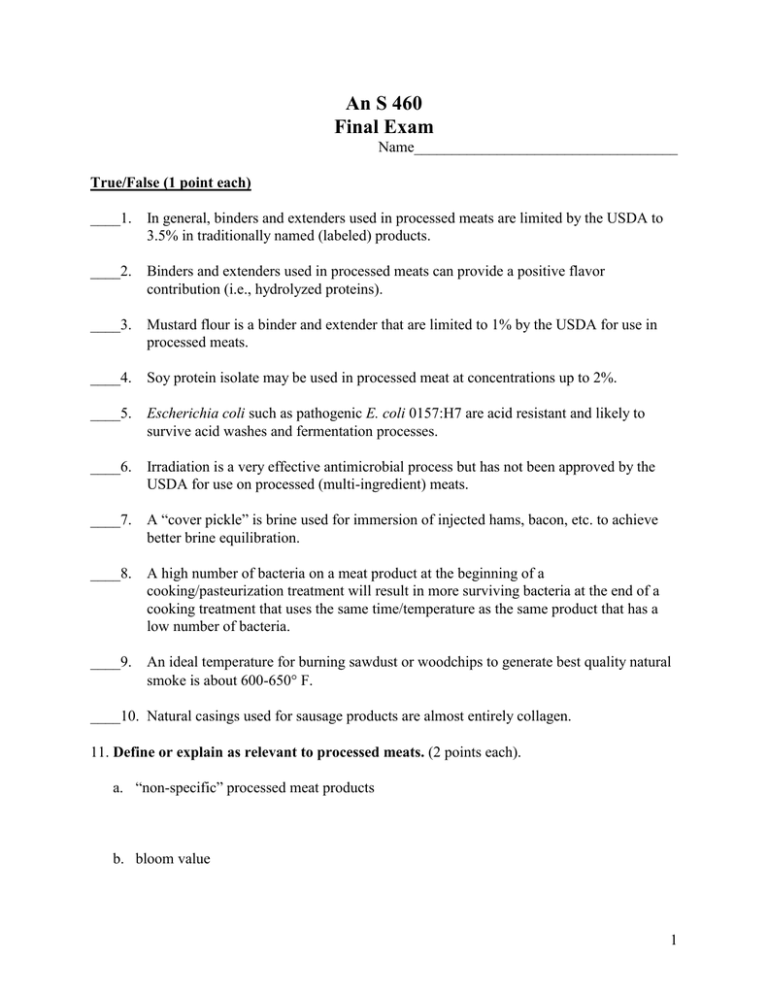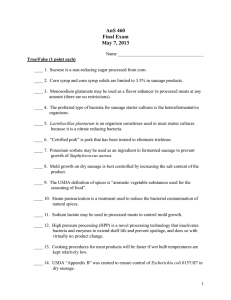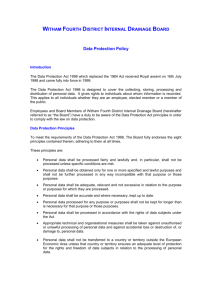An S 460 Final Exam
advertisement

An S 460 Final Exam Name___________________________________ True/False (1 point each) ____1. In general, binders and extenders used in processed meats are limited by the USDA to 3.5% in traditionally named (labeled) products. ____2. Binders and extenders used in processed meats can provide a positive flavor contribution (i.e., hydrolyzed proteins). ____3. Mustard flour is a binder and extender that are limited to 1% by the USDA for use in processed meats. ____4. Soy protein isolate may be used in processed meat at concentrations up to 2%. ____5. Escherichia coli such as pathogenic E. coli 0157:H7 are acid resistant and likely to survive acid washes and fermentation processes. ____6. Irradiation is a very effective antimicrobial process but has not been approved by the USDA for use on processed (multi-ingredient) meats. ____7. A “cover pickle” is brine used for immersion of injected hams, bacon, etc. to achieve better brine equilibration. ____8. A high number of bacteria on a meat product at the beginning of a cooking/pasteurization treatment will result in more surviving bacteria at the end of a cooking treatment that uses the same time/temperature as the same product that has a low number of bacteria. ____9. An ideal temperature for burning sawdust or woodchips to generate best quality natural smoke is about 600-650 F. ____10. Natural casings used for sausage products are almost entirely collagen. 11. Define or explain as relevant to processed meats. (2 points each). a. “non-specific” processed meat products b. bloom value 1 c. caseinate d. Fibrimex e. sodium lactate f. sodium diacetate g. massaging h. stabilization i. ΔT j. electrostatic smoking k. hanks l. prestuck m. co-extrusion 2 n. synergistic o. intoxication 12. (10 points) List 5 of the major food allergens that is likely to induce allergic reactions in some individuals. 13. (10 points) Describe 5 recommended practices that will help to control the risk of unintentionally including an allergen in a processed meat product. 3 14. (10 points) Describe 5 processes or ingredients that are effective for reducing bacterial contamination on carcasses, fresh meats or finished products. 15. (10 points) List at least five advantages to using tumbling for injected cured meats such as boneless hams. 4 16. (10 points) List the five general categories of chemical compounds found in natural wood smoke and describe the effects of each on smoked meat products. 17. (10 points) List 3 of the pathogenic bacteria of concern to processed meats and describe the product and/or conditions where each is most likely to be a problem. 5 18. (10 points) What is the objective of USDA “Alternatives 1, 2 and 3” for processed meats and what does each alternative include? The above questions totaled 100 points for this exam. The following questions may be answered for extra credit. 19. (14 points) What 7 items of information must be included on every processed meat product label? 6 20. (5 points) Why is wet bulb temperature in a smokehouse always less than (or sometimes equal to) the dry bulb temperature but never greater than dry bulb temperature? 7


